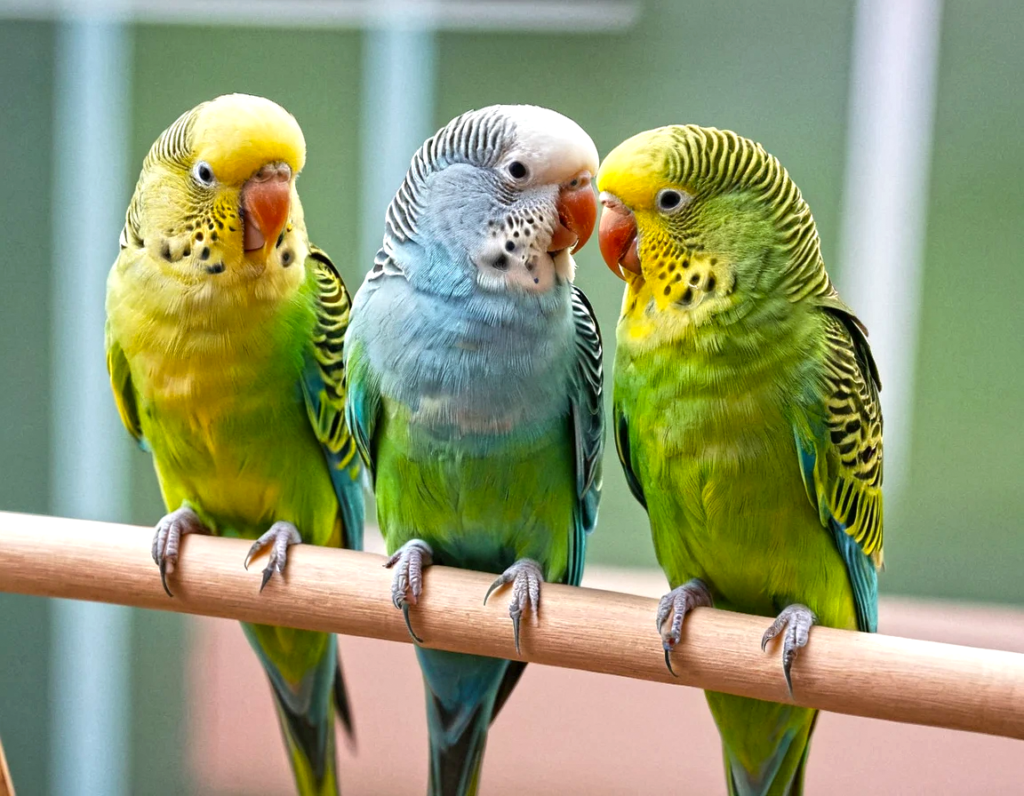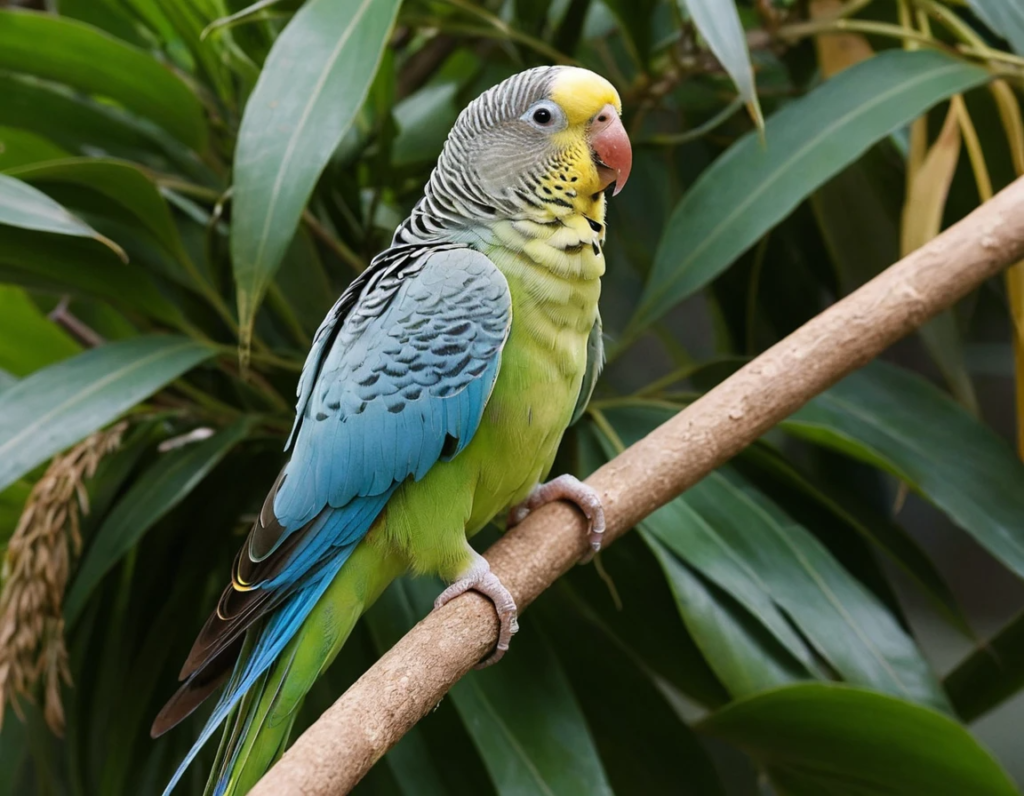
How to Tell if Parakeets Are Ready to Mate
Parakeets may be tiny, but when it comes to love, they don’t hold back. If you’ve got a pair of these feathery lovebirds and you’re wondering if they’re ready for parakeet mating, you’re in the right place. Parakeets have their own way of saying, “Hey, I think you’re cute,” and it’s pretty adorable. Let’s go over the signs that your parakeets are ready to take the next step!
They’re Becoming the Best of Friends
Parakeets don’t just rush into relationships (unlike some people on dating apps). If you notice your birds spending a lot of time together—perching close, preening each other, and sharing food—it’s a big sign that love is in the air. Grooming is like a parakeet’s way of saying, “You’ve got a feather out of place, darling. Let me fix that.”
Increased Chirping and Singing
When parakeets are in the mood for romance, the male often turns into a little opera singer. He’ll chirp, sing, and maybe even throw in a few whistles to impress his lady friend. If your male parakeet starts singing his heart out like he’s auditioning for a bird version of “The Voice,” he’s definitely trying to woo his partner for some parakeet mating.
Head Bobbing and Flirting
If your male parakeet is bobbing his head up and down like he’s at a rock concert, he’s feeling flirty. This is one of the most obvious signs of courtship. The female might respond by bobbing her head back or simply watching him like, “Alright, show me what you got.”
Feeding Each Other (Yes, It’s Cute)
Parakeets show affection by regurgitating food for each other. It may sound a little gross to us, but in the bird world, it’s the equivalent of sharing a romantic dinner. If your male parakeet is feeding his mate, it’s a clear sign that he’s serious about their relationship and ready for parakeet mating.
Nesting Behavior Begins
When a female parakeet is preparing for a family, she’ll start investigating potential nesting spots. She might chew on paper, wood, or anything that could make a cozy little nest. If she’s suddenly obsessed with tearing up your newspaper, she’s probably getting ready to lay some eggs.
More Physical Contact
Parakeets that are getting ready to mate will start nudging each other, touching beaks, and even leaning on each other more often. If they look like they can’t get enough of each other’s company, they’re definitely in the honeymoon phase.
The Male Gets More Persistent
Male parakeets can be a little… enthusiastic. If he starts following the female around, constantly singing and trying to get her attention, he’s eager for parakeet mating. If the female is interested, she’ll respond positively; if not, she might give him a little peck to tell him to cool it.
Final Thoughts
Parakeets have their own adorable way of showing that they’re ready to mate. From singing and dancing to feeding and cuddling, these little lovebirds make their feelings pretty clear. If you notice these behaviors, it might be time to set up a cozy nesting box and prepare for some tiny, chirping additions to your bird family.
Just remember—if your parakeets aren’t showing these signs, don’t rush them! Love takes time, even in the bird world. After all, even parakeets need the right mood and the right partner to make things happen.
So, keep an eye out for these signals, and who knows? You might soon have a full house of feathery little fluff balls! 🐥
Parakeet Mating Rituals and Courtship Behavior
Parakeets may be small, but when it comes to romance, they pull out all the stops. If you’ve ever watched a pair of these feathery charmers, you’ll know that parakeet mating involves more than just fluttering around and looking cute. These little birds have an entire courtship routine, and it’s as entertaining as a reality dating show (minus the drama).
The Singing Serenade 🎶
Male parakeets are quite the performers when they’re smitten. If you notice your male parakeet singing his heart out while bobbing his head enthusiastically, he’s basically trying to impress his crush. Think of it as a parakeet love song—except there’s no need for a Spotify playlist.
The Head-Bobbing Dance 💃🕺
If a male parakeet is really into his potential mate, he’ll start bobbing his head up and down like he’s at the best party of his life. This quirky move isn’t just for show; it’s an important part of parakeet mating. If the female is interested, she may respond with some head-bobbing of her own, signaling that she’s open to his advances.
Love Through Feeding 🍽
️
Sharing is caring, and in the parakeet world, regurgitating food for a mate is the ultimate romantic gesture. Yes, it might sound unappealing to us, but to a parakeet, this is the equivalent of bringing home a fancy dinner. If a male parakeet starts feeding his lady, it’s a clear sign that he’s head over tail for her.
Beak Touching (A.K.A. Bird Kissing) 💋
When parakeets touch beaks, it’s basically their version of a kiss. This adorable act strengthens their bond and reassures the female that the male is serious about parakeet mating. If you see your birds nudging and gently pecking at each other’s beaks, they’re definitely in the “getting serious” phase of their relationship.
The Nesting Instinct 🏡
Once the romance is in full swing, the female starts preparing for the next step—finding the perfect nesting spot. She may chew on wood, shred paper, or obsess over a particular corner of the cage. This means she’s getting ready to settle down and start a family.
The Grand Finale: The Mating Process 🌟
If all the courtship behaviors go well, the male will make his move. He will hop onto the female’s back for a brief but important moment. If successful, the female will soon lay eggs, and the parakeet family journey begins!
Final Thoughts
Parakeet mating is a fascinating and adorable process filled with singing, dancing, and even a little bit of food-sharing romance. If you notice these behaviours in your birds, congratulations! Love is in the air. Just make sure to provide them with a comfortable and safe nesting area so they can continue their adorable love story.
Remember, not all parakeet pairs will click instantly—just like humans, some need a little more time to warm up to each other. So, sit back, enjoy the show, and let nature take its course. Who knew parakeet love could be this entertaining? 🐦💕
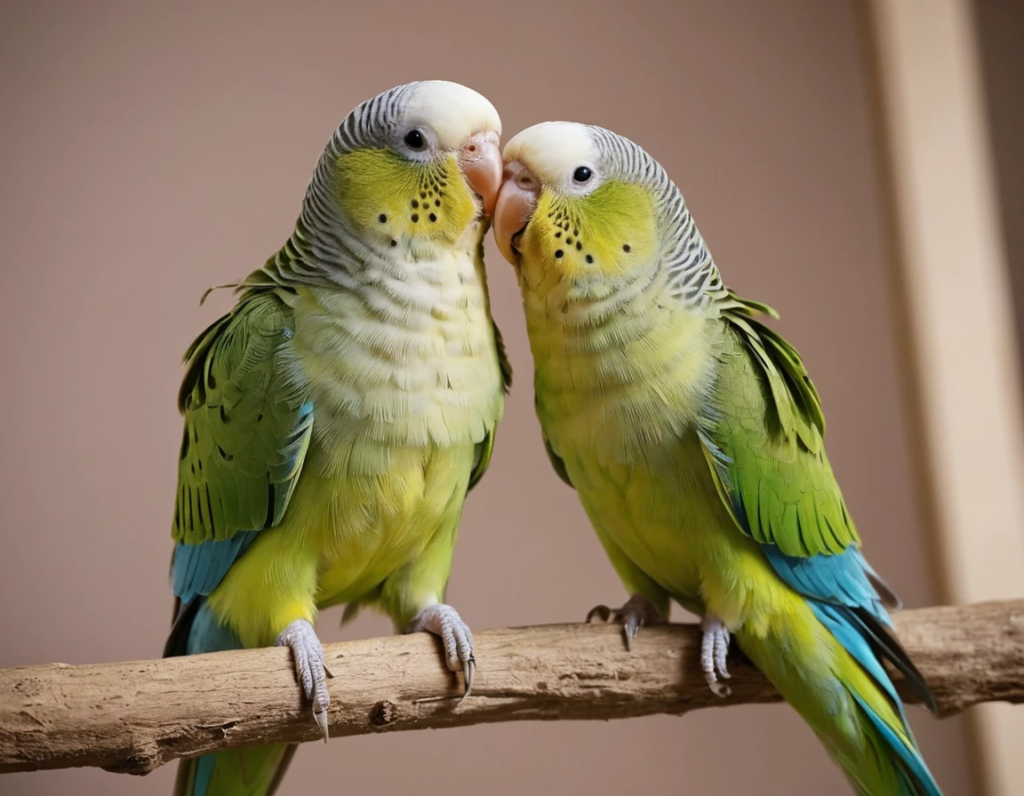
How to Encourage Parakeets to Mate
So, you’ve got a pair of parakeets, and you’re hoping they’ll hit it off and start a little birdie family. But instead of love songs and cuddles, they’re just sitting on opposite sides of the cage giving each other the cold shoulder. What gives? Encouraging parakeet mating takes a bit of preparation, patience, and the right mood-setting. Here’s how to help your feathered friends get in the mood for love.
1. Make Sure You Have a Compatible Pair 🐦❤️🐦
First things first, you need a male and a female. This might seem obvious, but sometimes even pet stores get it wrong. Check their cere (the area above the beak); males usually have a blue cere, while females have a brown or tan one. If you’re unsure, consult an avian expert—otherwise, you might just be waiting forever for parakeet mating to happen!
2. Set the Mood with the Right Environment 🌿🌞
Parakeets won’t just start mating in any random setting. They need to feel safe, comfortable, and a little romantic. Here’s what you can do:
- Cage Size Matters: Make sure their cage is spacious enough for them to move around freely.
- Proper Lighting: Natural daylight or full-spectrum bird lights help mimic breeding conditions.
- A Quiet & Stress-Free Zone: Too much noise or sudden disturbances can put a damper on romance.
3. Provide a Nutritious Love-Boosting Diet 🍏🥕
Even parakeets need a good diet to feel their best. A diet rich in protein and nutrients encourages parakeet mating. Offer:
- Fresh fruits and vegetables
- Sprouted seeds (parakeets love these!)
- Hard-boiled eggs (for extra protein)
- A calcium source like cuttlebone for healthy egg production
A well-fed bird is a happy bird—and happy birds are more likely to get in the mood.
4. Introduce a Nesting Box 🏡
Nothing screams “ready for a family” like the perfect home. Adding a nesting box inside the cage gives the female a safe space to lay her eggs. She might start chewing on wood or paper—this means she’s in full nesting mode!
5. Let Them Bond Naturally 💕
You can’t force love—parakeets need time to build a bond. If they’re not hitting it off immediately, don’t worry. Encourage interaction by:
- Letting them preen each other (a sign of trust)
- Providing shared food dishes
- Keeping them together but not rushing things
If they start feeding each other or sitting close, congratulations! You’re on your way to successful parakeet mating.
6. Keep the Temperature Just Right 🌡️
Parakeets are most likely to mate in warm conditions. Keep their environment between 65-75°F (18-24°C). Too cold, and they’ll be more focused on staying warm rather than romance!
7. Be Patient and Observe ⏳
Not all pairs will mate right away. Some take weeks or even months before they’re ready. Keep an eye on their behavior—if the female starts spending time in the nesting box, you’re getting close!
Final Thoughts
Parakeet mating doesn’t happen overnight, but with the right environment, nutrition, and patience, you can help set the stage for love. Just remember, no pressure—your birds will take their time, and when they’re ready, you’ll have a front-row seat to the cutest little parakeet family in the making!
Now, go grab some birdseed, dim the lights, and let nature do its thing. Who knew being a parakeet matchmaker could be so much fun? 🐦💞
How to Identify Male vs. Female Parakeets
So, you’ve got yourself a parakeet (or maybe two), and now you’re playing detective, trying to figure out whether you’ve got a little gentleman or a feathery lady. Good news! Unlike some animals where gender identification requires a degree in zoology, telling male and female parakeets apart isn’t too tricky—once you know what to look for.
The Magic of the Cere 🌈
No, not “cereal”—we’re talking about the cere, the fleshy area right above your parakeet’s beak where the nostrils are. This little patch is the best way to distinguish males from females. Here’s the breakdown:
- Males: Typically have a bright blue or purplish cere (except for some color mutations, but we’ll get to that later!). If your bird’s cere is smooth and vibrantly blue, congratulations, you have a boy!
- Females: Usually have a tan, brown, or whitish cere. When they’re hormonal or ready for parakeet mating, their cere can darken and even become a crusty brown (yes, love is weird sometimes).
Behavior Speaks Volumes 🐦
If cere color isn’t giving you a clear answer, watching your parakeet’s behavior might do the trick.
- Male Parakeets: Think of them as the social butterflies of the bird world. They are more likely to sing, chatter, and perform little dances. If your parakeet is always the life of the party, showing off and whistling non-stop, chances are, it’s a boy.
- Female Parakeets: They tend to be quieter and more reserved. While they do chirp, they’re not as talkative as the males. They’re also known to be a bit bossier—if your bird is ruling the roost and making the big decisions (like who gets to eat first), you probably have a female.
Parakeet Mating Clues ❤
If your parakeets are spending time together and engaging in courtship behaviors, this can give you a strong hint about their gender.
- Males usually feed the female as part of their wooing ritual.
- Females are the nest-builders and will start preparing a cozy spot when they’re in the mood for parakeet mating.
- If you see one bird bobbing its head and singing while the other looks unimpressed, chances are, the performer is the male.
What About Color Mutations? 🎨
If your parakeet isn’t the standard green-and-yellow variety, cere colors can be a bit trickier. Albino, lutino, and certain pastel mutations may have pink or light purple ceres, making it harder to tell their gender. In these cases, behavior is your best clue!
DNA Testing: The Ultimate Answer 🧬
If all else fails and you really need to know your parakeet’s gender (maybe for breeding or just because curiosity is eating you alive), a simple DNA test can give you a definitive answer. Some avian vets offer this service, and it’s painless for your feathered friend.
Final Thoughts
Telling male and female parakeets apart is usually as easy as checking the cere color, but their behavior and interactions—especially during parakeet mating season—can also give you solid clues. Just remember, no matter the gender, your parakeet is a unique little character with its own personality.
So, whether you’ve got a singing Romeo or a feisty Juliet, one thing’s for sure—you’re in for an entertaining time with your parakeet! 🐦🎉
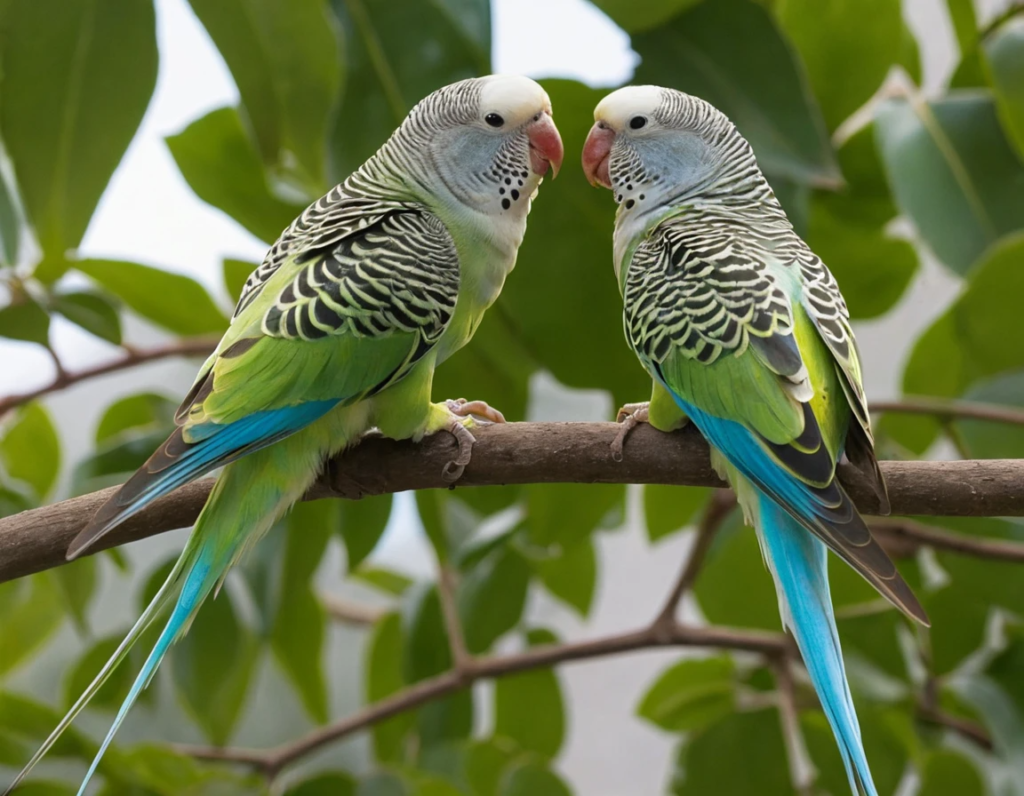
How Long Does It Take for Parakeets to Mate and Lay Eggs?
So, you’ve got a pair of parakeets, and you’re wondering when they’ll get busy and start a little birdie family. Parakeet mating isn’t an instant process—it takes time, patience, and the right conditions. But don’t worry, I’ll break it down for you in a way that actually makes sense (and maybe give you a chuckle along the way!).
The Courtship Phase 💕
Before anything happens, your parakeets need to feel the love. This phase can take anywhere from a few days to a few weeks, depending on how comfortable they are with each other.
- Signs of interest: Singing, beak-touching (parakeet kisses), head bobbing, and the ultimate romantic gesture—feeding each other.
- If your birds are still sitting at opposite ends of the cage pretending the other doesn’t exist, you might need to give them more time!
The Actual Mating Process 🐦❤
Once the love is in the air, the real action begins. Parakeet mating is usually quick, lasting only a few seconds per session. But don’t be fooled—this can happen multiple times a day.
- The male will often hop onto the female’s back, balancing like an acrobat for a brief moment.
- If the female is in the mood, she will lift her tail slightly to help.
- If she’s not in the mood… well, let’s just say he might get a firm peck to remind him who’s boss.
- Egg-Laying Time! 🥚
After successful mating, the female won’t lay eggs immediately. Instead, she takes about 8-10 days to start laying.
- She will typically lay one egg every other day until she has around 4-6 eggs.
- If you see her spending more time in the nesting box, rearranging things like a tiny interior designer, she’s getting ready.
The Incubation Period ⏳
Once the last egg is laid, the real waiting game begins. The female will start incubating the eggs, which takes around 18-21 days before they hatch.
- She rarely leaves the eggs except to grab a quick snack.
- The male will play the role of supportive partner, feeding her and standing guard like a proud dad-to-be.
What If They’re Not Mating? 🤔
Sometimes, your parakeets might not be in the mood. Here’s what you can do to encourage parakeet mating:
- Provide a cozy nesting box (because even birds need a comfortable space to start a family).
- Ensure they have a nutritious diet with calcium-rich foods like cuttlebone.
- Give them privacy—no one wants an audience when they’re romancing.
Final Thoughts
In total, from parakeet mating to hatching, you’re looking at about a month and a half (give or take a few days). It’s a fascinating process, and if you’re patient, you’ll soon have adorable, fluffy baby parakeets chirping away.
So, if your birds are still in the “awkward flirting” stage, don’t stress—love takes time. But once they start, you’ll be amazed at how fast nature takes its course! 🐦💛
Do Parakeets Mate for Life?
If you’ve ever watched a pair of parakeets snuggling, preening, and feeding each other like lovebirds (pun intended), you might wonder—do parakeets mate for life? Are these little feathered romantics truly committed, or do they just enjoy a good fling before moving on?
Let’s dive into the world of parakeet mating and find out if they’re the relationship goals we think they are!
The Truth About Parakeet Mating Bonds ❤
️Parakeets are social birds that form strong pair bonds, but are they forever bonds? Well, yes and no.
- In the wild, parakeets tend to stick with a mate for a long time, often for life.
- However, if circumstances change—like the loss of a partner or a lack of bonding—they will move on and find a new mate.
- Unlike some other birds (like swans, who are basically the hopeless romantics of the bird world), parakeets can be a little more flexible in their love lives.
Signs of a Strong Pair Bond 🐦💑
When parakeets find their match, they display some seriously adorable behavior:
- Preening each other (like a tiny spa day)
- Sitting close together—if one moves, the other follows
- Feeding each other, which is basically the parakeet version of sharing a romantic dinner
- Chirping sweetly to each other like a couple in the honeymoon phase
If your parakeets are doing all this, they’re definitely in a solid relationship!
What Happens If a Mate is Lost? 😢
Here’s where things get a little sad. If one parakeet loses its mate, it may grieve—sometimes even refusing to eat or interact for a while. But after some time, most parakeets will be open to forming a new bond.
So while they can be deeply attached, they also have the ability to find love again. Move over, Hollywood rom-coms—parakeet mating stories are just as dramatic!
Do Parakeets Need a Mate? 🤔
If you’re wondering whether your parakeet must have a mate, the answer is no, but…
- Parakeets are very social, so if you only have one, make sure to give it plenty of attention.
- A bonded pair will keep each other entertained, reducing loneliness.
- However, if you’re introducing a new mate, don’t expect instant love—sometimes it takes time for them to warm up to each other!
Final Thoughts
So, do parakeets mate for life? Sometimes! While they form deep, affectionate bonds, they can also adapt and find new partners if needed. Whether you have a single parakeet or a bonded pair, the key is making sure they feel happy and secure in their environment.
At the end of the day, parakeet mating isn’t just about romance—it’s about companionship. And let’s be honest, whether they mate for life or not, watching their adorable interactions is enough to melt anyone’s heart! 🐦💕
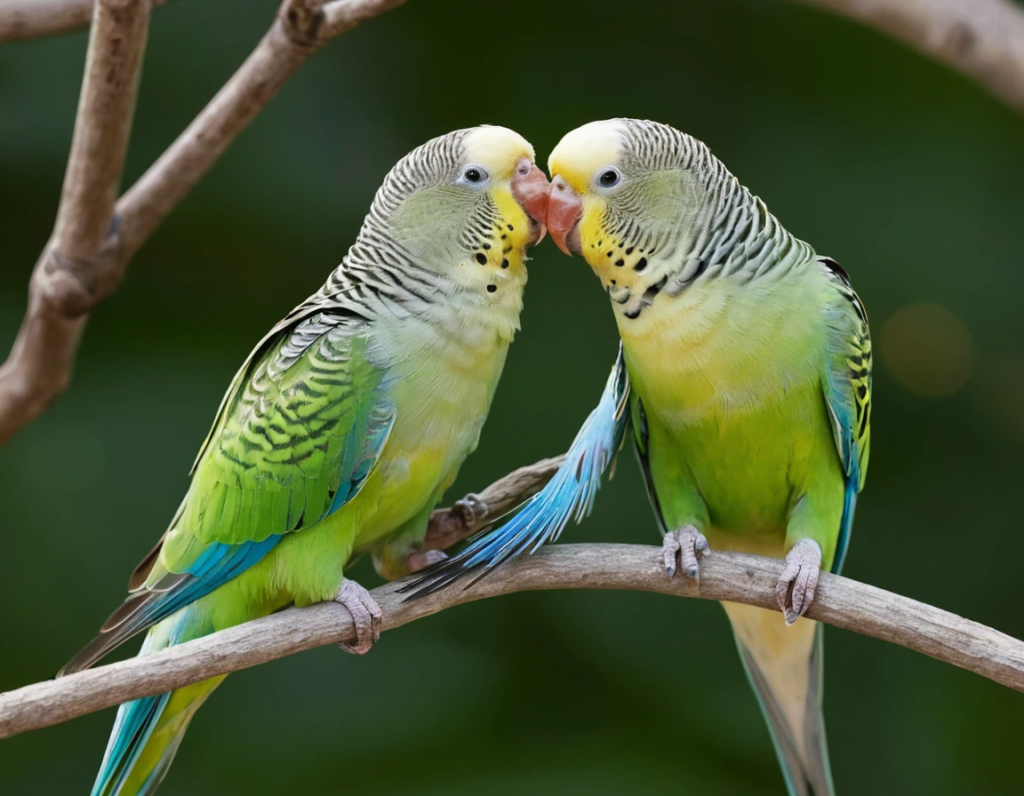
Why Are My Parakeets Not Mating?
So, you got yourself a pair of parakeets, set up a cozy little love nest, and expected them to start a birdie romance right away. But instead of parakeet mating magic, you’re just getting a lot of chirping, staring, and maybe some side-eye. What gives? If your parakeets aren’t in the mood for love, there could be several reasons why. Let’s break it down!
Are They Even a Male and a Female? 🤷♂️
First things first—are you sure you have a male and a female? Sometimes, pet stores make mistakes, and you could actually have two boys, two girls, or even a couple of birds that just aren’t interested in each other.
- Male parakeets usually have a bright blue cere (the fleshy part above the beak).
- Female parakeets typically have a tan or brownish cere.
- If you’re unsure, a vet can help confirm their genders!
They’re Just Not That Into Each Other 💔
Even if you have a male and a female, that doesn’t mean they’ll instantly fall in love. Parakeets, like people, have personalities and preferences. If they don’t vibe, they’re not going to mate—simple as that.
- Some parakeets bond instantly, while others need time.
- If they fight often or keep their distance, they might not be a good match.
- Try introducing a different mate if possible!
The Environment Isn’t Romantic Enough 🌿
Parakeet mating won’t happen if the mood isn’t right. If their cage setup isn’t ideal, they may not feel comfortable enough to start a family.
- Cage size matters—a cramped space = cranky birds.
- Provide a cozy nesting box—no nest, no interest.
- Quiet and stability—loud noises and constant disruptions can kill the mood.
- Lighting—12 hours of daylight mimics breeding season conditions.
They’re Not Old Enough (or They’re Too Old!) 🎂
Age is a major factor in parakeet mating. If your birds are too young, they won’t be ready. If they’re too old, they might be over it.
- Parakeets usually reach maturity around 6 months to 1 year old.
- Ideal breeding age is between 1-4 years.
- Older birds may lose interest or have difficulty mating.
Their Diet Needs an Upgrade 🍏
A proper diet plays a huge role in parakeet mating success. If they’re not getting the right nutrients, their bodies won’t be in breeding mode.
- Provide fresh fruits and vegetables daily.
- High-protein foods like boiled eggs and sprouted seeds can help.
- A cuttlebone ensures they get enough calcium for strong eggshells.
They’re Stressed Out 😬
Parakeets are sensitive creatures, and stress can completely shut down their interest in mating.
- New surroundings—Did you recently move their cage?
- Other pets—Is your cat giving them “hungry” stares?
- Too much handling—Give them some space to bond naturally.
- It’s Just Not the Right Time ⏳
Parakeets have natural breeding seasons, usually in spring and summer. If it’s winter, they might not be in the mood. Try adjusting their environment to mimic spring conditions with more daylight hours and fresh greens.
Final Thoughts
Parakeet mating isn’t always instant, and there are many reasons why your birds might not be getting romantic. Check their age, diet, and environment, and give them time to bond. If all else fails, maybe they just prefer the single life—and that’s okay too!
At the end of the day, happy and healthy birds are what matter most. So keep an eye on them, make small improvements, and who knows—maybe love will be in the air soon! 🐦💘
How to Set Up a Nesting Box for Parakeets
So, your parakeets are getting cozy, and you’re thinking it’s time to set up a nesting box? Great choice! If you want successful parakeet mating and tiny chirping fluffballs in the near future, a proper nesting box is a must. But don’t worry, setting one up isn’t rocket science—I promise! Let’s break it down step by step.
Choosing the Right Nesting Box 🏡
Not all nesting boxes are created equal, and parakeets can be a little picky when it comes to their homes.
- Material: Wood is the best choice—it’s sturdy, provides insulation, and feels more natural to your birds.
- Size: A good nesting box should be around 10 x 6 x 6 inches to give your parakeets enough space.
- Entrance Hole: About 1.5 inches in diameter—big enough to get in but small enough to feel safe.
- Lid or Side Opening: You’ll need access to check on eggs and chicks, so make sure it has a way to open without disturbing them too much.
Placement Matters! 📍
Where you place the nesting box is just as important as the box itself.
- Inside the Cage vs. Outside: Some boxes attach to the outside of the cage with an opening leading in. This saves space inside and gives your parakeets a little more privacy.
- Height is Key: Mount the box higher up in the cage—parakeets feel safer nesting at an elevated spot.
- Away from Noise & Stress: Keep the cage in a quiet area, away from loud TVs, barking dogs, or anything that could stress out your birds.
Make it Comfortable 🛏
️Would you want to raise a family in an empty, uncomfortable space? Neither do your parakeets!
- Nest Lining: Use soft wood shavings (like aspen) for comfort and warmth. Avoid cedar—it has strong fumes that can be harmful.
- Hollowed Base: A small, concave dip in the bottom of the box helps keep eggs from rolling around.
- No Overcrowding: If you have multiple pairs of parakeets, each couple needs its own nesting box.
Prepping Your Parakeets for Nesting 🐦
A good nesting box is just one part of the equation—your parakeets need to be in the mood for parakeet mating too!
- Diet Boost: Increase calcium intake (cuttlebones, crushed eggshells) for stronger eggs.
- 12+ Hours of Light: Mimic natural breeding conditions by ensuring they get enough daylight.
- Give Them Privacy: No peeking every five minutes—parakeets need space to feel safe enough to breed.
Keeping an Eye on Things 👀
Once your birds start using the nesting box, keep an eye on their behavior.
- Are they spending time inside? That’s a good sign!
- Do they seem aggressive? Too much stress can ruin the breeding process, so make sure they’re getting along.
- Egg Watch: Parakeets usually lay 4-6 eggs, one every other day. If you notice eggs but no incubation, give them a little more time.
Final Thoughts
Setting up a nesting box for your parakeets is a simple but crucial step in encouraging parakeet mating and ensuring a safe, comfortable environment for future chicks. With the right box, placement, and preparation, you’ll be well on your way to having a happy bird family.
So, set up that box, step back, and let love take its course—just try not to eavesdrop too much! 🐦💕
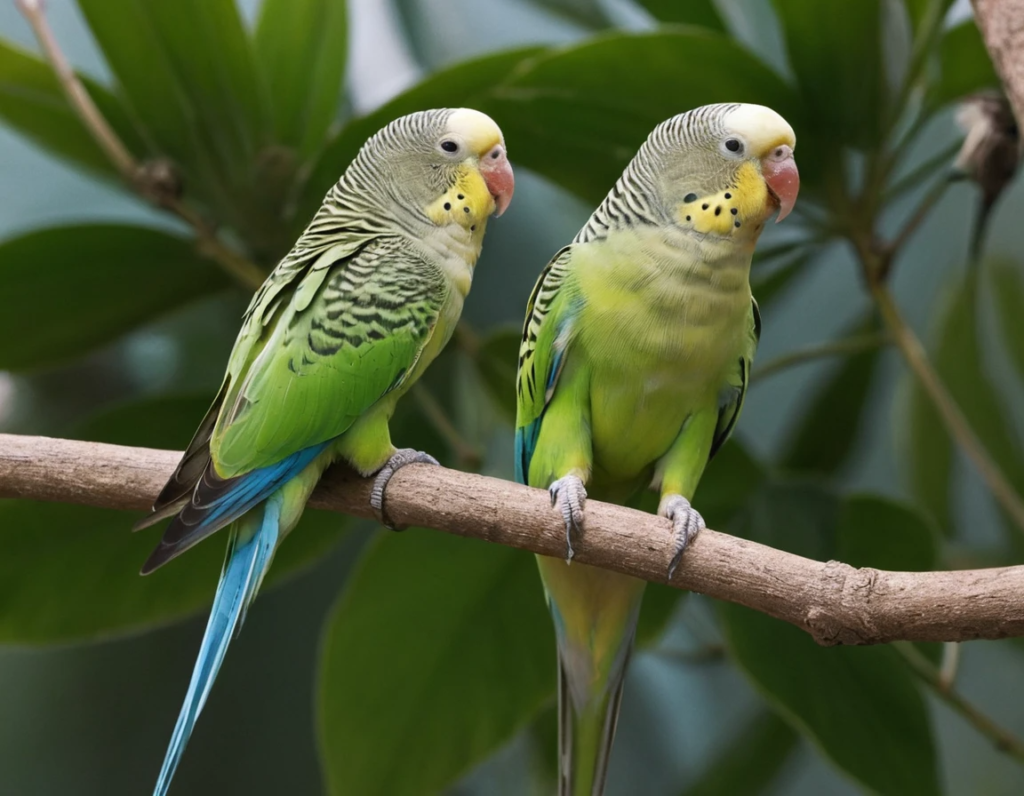
Parakeet Egg Laying and Incubation
So, your parakeets have gone through the whole parakeet mating process, and now you’re wondering what happens next. Egg-laying and incubation are fascinating stages, but they require a bit of patience (and maybe a little birdie drama along the way). Let’s break it down into simple, easy-to-follow steps—with a bit of humor to keep things interesting!
- When Do Parakeets Lay Eggs? 🥚
After successful parakeet mating, the female won’t waste much time. Within 8-10 days, she’ll start laying eggs. If you see her spending extra time in the nesting box, fluffing things up like an interior decorator, it’s a good sign that eggs are on the way!
- Parakeets typically lay one egg every other day until they have around 4-6 eggs.
- If you see your female parakeet looking a little rounder than usual, she might be preparing to lay.
- Mood swings? Oh yes! Your once-sweet parakeet might suddenly become the queen of sass. Totally normal.
- Egg Incubation – The Waiting Game ⏳
Once the last egg is laid, the real waiting begins. The female parakeet will start incubating the eggs, which takes about 18-21 days before they hatch.
- Mom’s job: The female will sit on the eggs almost non-stop, keeping them warm.
- Dad’s job: The male usually plays the role of the food delivery service, feeding his mate while she stays on the eggs.
- Don’t panic! If the eggs don’t hatch right on time, give them an extra few days—sometimes nature runs on its own schedule.
- How to Know If the Eggs Are Fertile? 🔍
Not all eggs will be fertile, and that’s okay! You can check fertility using the candling method—which sounds fancy but is really just shining a flashlight through the egg to see if there’s a developing chick inside.
- After about a week of incubation, you might see tiny red veins—this means the egg is fertile.
- If the egg looks clear, it might not be fertilized, but wait a few more days before making a final call.
- Be gentle—handling the eggs too much can disturb the incubation process.
- Common Problems and What to Do 🤔
Sometimes, things don’t go as planned. Here are a few common egg-laying problems and how to handle them:
- Egg binding (when a female struggles to lay an egg) can be serious—if she looks weak or puffy, consult an avian vet.
- Infertile eggs are common; just remove them after a few weeks if they don’t hatch.
- Too many eggs? If your parakeet lays a crazy amount (like 10+), she might need a break. Reduce daylight hours to signal it’s not breeding season.
- What Happens After the Eggs Hatch? 🐣
Once the chicks start hatching, the real fun begins!
- Hatchlings are completely bald, blind, and helpless, but mom and dad will take great care of them.
- The female keeps them warm while the male continues to bring food.
- In about 10 days, their eyes open, and soft feathers start to appear.
Final Thoughts
Parakeet egg-laying and incubation is a fascinating process, but it requires a little patience and a lot of trust in nature. If your birds are going through parakeet mating and nesting, be supportive but give them space. Before you know it, you might have a nest full of chirping fluffballs!
Just remember, once those babies hatch, you’re officially running a tiny bird daycare—so get ready for some adorable chaos! 🐦💕
Caring for Parakeet Chicks After Hatching
Congratulations! Your parakeets have successfully gone through the parakeet mating process, and now you have tiny, squeaky, featherless chicks in the nest. So, what now? Caring for parakeet chicks after hatching can be both exciting and a little nerve-wracking, but don’t worry—I’ve got you covered with simple, practical steps (and a bit of humor to keep things light!).
Let the Parents Do Their Job 🐦
First things first—don’t panic! The parent parakeets know what they’re doing. The mother will keep the chicks warm, while the father will bring food. Your job? Mostly just watch and admire.
- Avoid interfering too much; mama parakeet doesn’t need a babysitter.
- Keep an eye on both parents to make sure they’re feeding the chicks.
- If the male isn’t pulling his weight, you might need to step in with extra food for mom.
Keep the Nest Clean (Without Causing Drama) 🧹
Parakeet chicks might be tiny, but they sure can make a mess! A clean nest is crucial for their health.
- When to clean? After about 10 days, when the chicks are a bit stronger.
- How to clean? Gently remove soiled nesting material and replace it with fresh, soft wood shavings.
- Pro tip: Don’t go overboard—too much cleaning can stress the parents out.
Feeding Time: What’s on the Menu? 🍽️
For the first two weeks, the mother will feed her chicks a special formula called crop milk (don’t worry, you don’t need to prepare it—nature’s got this covered). After that, the diet changes.
- Parents will start feeding the chicks softened seeds, fruits, and veggies.
- If you need to hand-feed a chick, use a special hand-feeding formula and a syringe (but only if absolutely necessary).
- Keep a calcium source (like a cuttlebone) available to keep mom strong.
Keeping the Chicks Warm ☀
Baby parakeets can’t regulate their body temperature, so warmth is crucial.
- The mother will keep them warm, but if she stops, you may need to provide a heat lamp or heating pad.
- The ideal temperature for young chicks is around 85°F (29°C).
- No need for a birdie sweater—just a cozy, controlled environment will do!
When Do They Start Looking Like Parakeets? 🐣➡️🐦
Right now, they might look like tiny pink aliens, but soon enough, they’ll transform into cute, fluffy parakeets!
- Day 10-14: Eyes open, pin feathers start appearing.
- Week 3-4: Feathers grow in, and they start exploring the nest.
- Week 5-6: They begin to leave the nest (a.k.a. the “toddler” stage—brace yourself!).
Socializing and Training 🦜
Once the chicks are around 6 weeks old, they’re ready to learn about the world!
- Start handling them gently to get them used to human interaction.
- Introduce them to a balanced diet beyond just seeds.
- If they have siblings, they’ll learn social skills by playing (and probably squabbling a little).
Final Thoughts
Caring for parakeet chicks after hatching is an amazing experience, but patience is key. Let the parents handle most of the work, step in when necessary, and enjoy watching these little fluffballs grow.
Before you know it, your once tiny chicks will be flapping around, causing mischief, and maybe even starting their own parakeet mating journey! 🐦💕
FAQs about Parakeet Mating
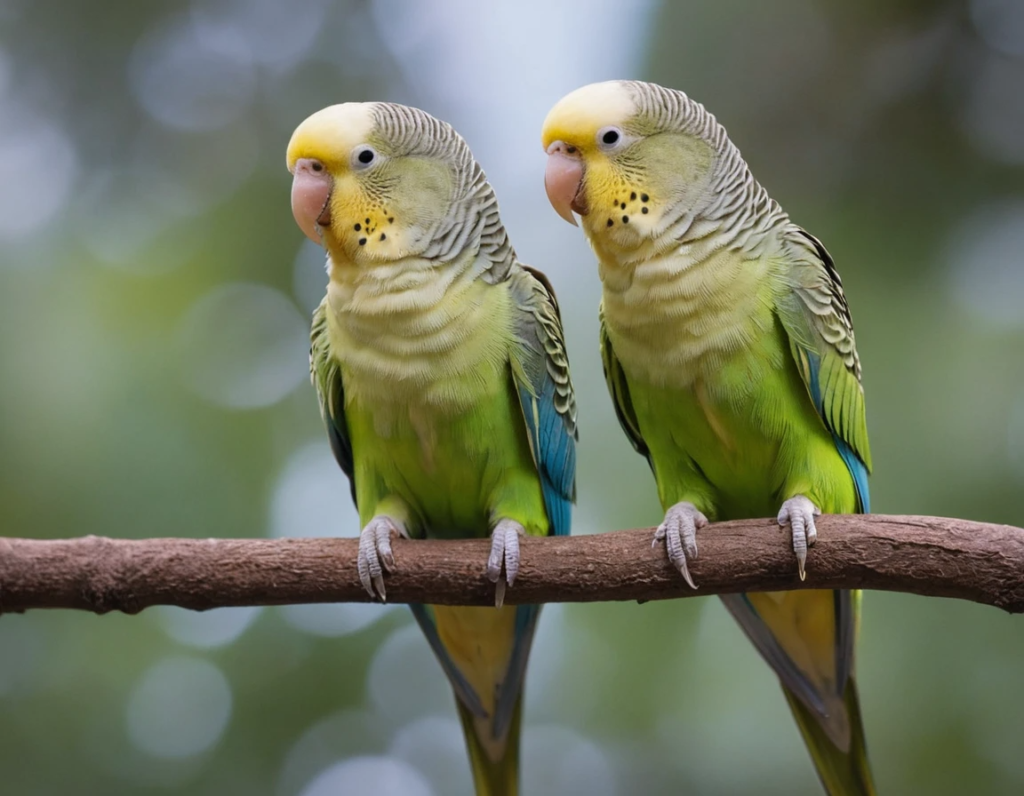
1. How do I know if my parakeets are ready to mate?
Answer: They start flirting—preening each other, feeding one another, and spending lots of time together. Basically, a feathery romance novel in the making.
2. Do parakeets mate for life?
Answer: Not necessarily! They form strong bonds, but they can switch partners if needed (kind of like a soap opera with wings).
3. How long does parakeet mating take?
Answer: The actual act is blink-and-you-miss-it fast—just a few seconds! But courtship can last for weeks.
4. What triggers parakeet mating?
Answer: Warmer temperatures, longer daylight hours, and a nutritious diet help get them in the mood.
5. Do male and female parakeets have to bond before mating?
Answer: Yes! They need to trust each other first. No bird likes a rushed relationship.
6. How often do parakeets mate?
Answer: Once they start, they can mate several times a day for a few weeks until the female starts laying eggs.
7. Do parakeets need a nesting box to mate?
Answer: Yes, a proper nesting box helps the female feel secure enough to lay eggs.
8. Can parakeets mate without laying eggs?
Answer: Yes, mating doesn’t always result in eggs—sometimes it’s just for bonding.
9. How do I encourage my parakeets to mate?
Answer: Provide a comfortable environment, a proper nesting box, a high-calcium diet, and some privacy.
10. How long after mating do parakeets lay eggs?
Answer: Usually within 8-10 days after successful mating.
11. Can parakeets lay eggs without a mate?
Answer: Yes, females can lay unfertilized eggs even without a male around. No baby birds, though!
12. How many eggs do parakeets lay?
Answer: Typically 4-6 eggs, laid one every other day.
13. How do I know if parakeet eggs are fertile?
Answer: Use the candling method (shining a light through the egg) after 5-7 days to check for veins inside.
14. What should I feed my parakeets during mating season?
Answer: Calcium-rich foods (cuttlebone, eggshells), fresh veggies, and a balanced diet to support healthy eggs.
15. Do parakeets get aggressive during mating?
Answer: Sometimes, yes! The male might get extra protective, and the female may act moody.
16. Can sibling parakeets mate?
Answer: Yes, but it’s not recommended as it can lead to genetic issues.
17. What should I do if my parakeets aren’t mating?
Answer: Check if they’re truly bonded, improve their diet, provide privacy, and ensure they’re the right age (over 6 months old).
18. How long does it take for parakeet eggs to hatch?
Answer: About 18-21 days after the female starts incubating them.
19. Do parakeets mate all year round?
Answer: They can, but they prefer spring and summer when conditions are ideal.
20. What happens if parakeets don’t get along?
Answer: No sparks? No problem. Sometimes they just don’t like each other—introducing a different mate may help!

